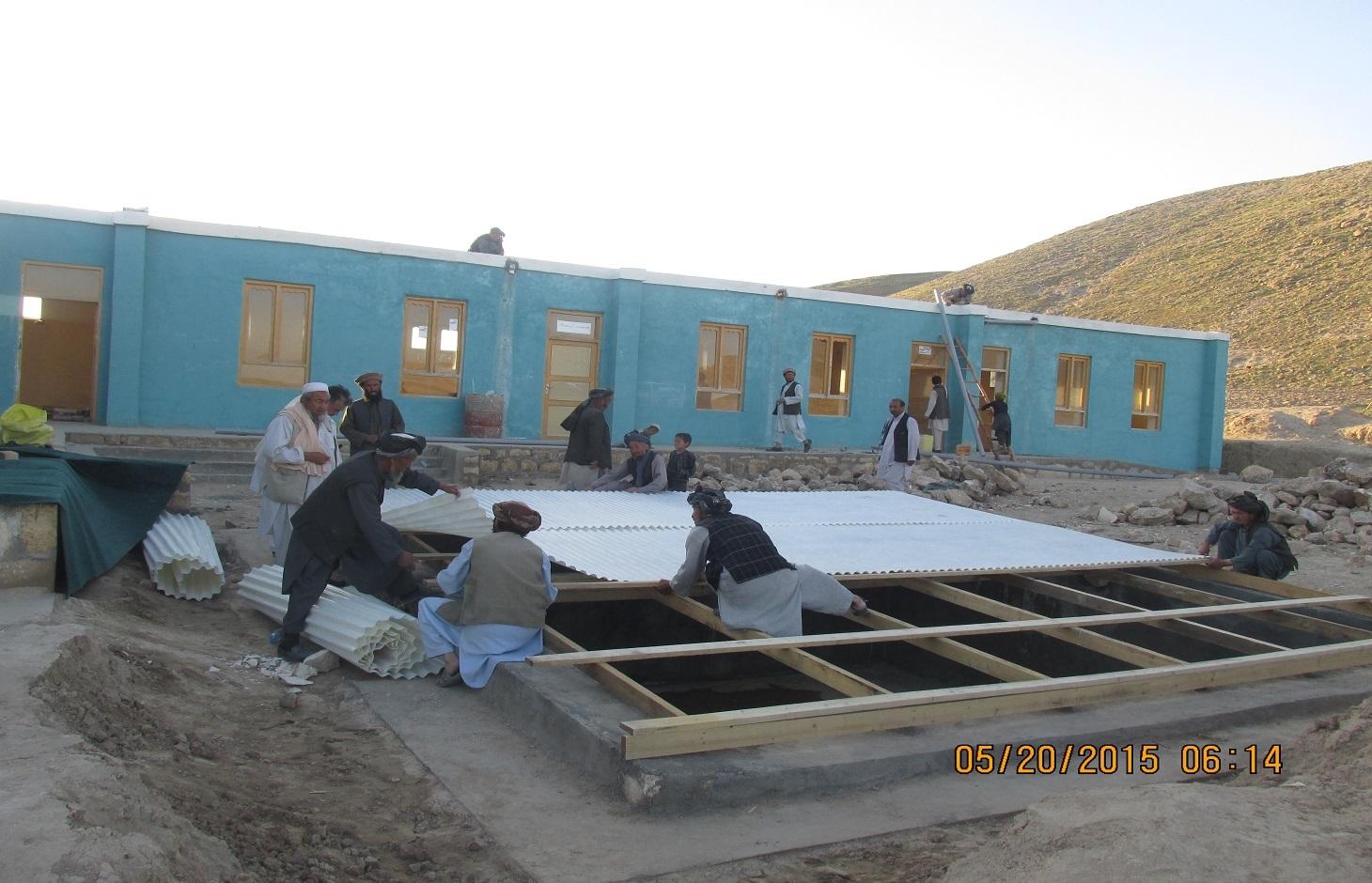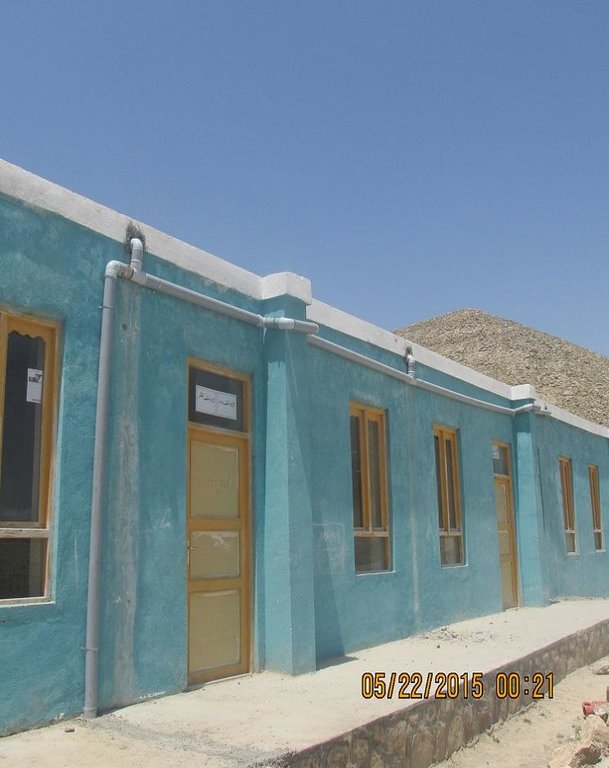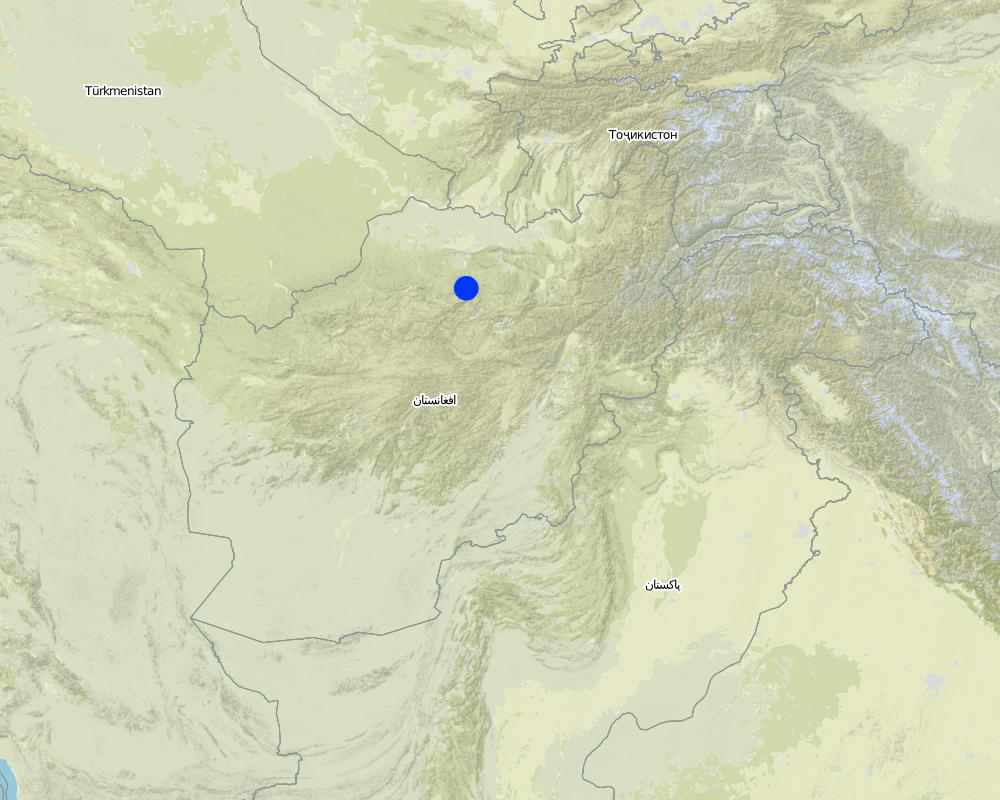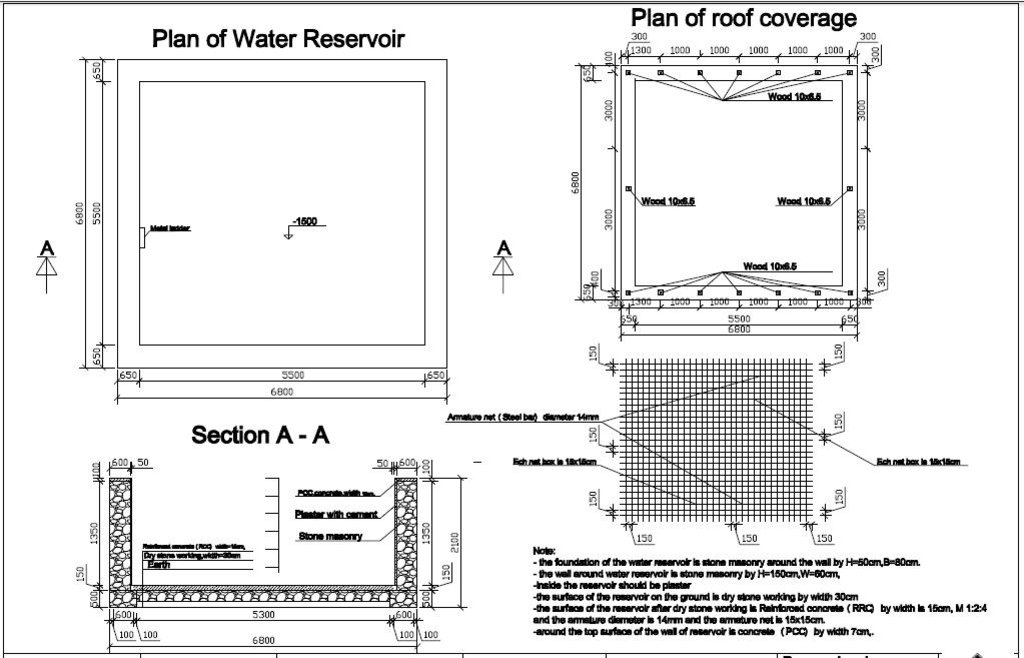Roof rain water harvesting [أفغانستان]
- تاريخ الإنشاء:
- تحديث:
- جامع المعلومات: Aqila Haidery
- المحرر: –
- المُراجع: Alexandra Gavilano
Jam aware ab-e-baran az bam
technologies_1728 - أفغانستان
عرض الأقسام
توسيع الكل طي الكل1. معلومات عامة
1.2 تفاصيل الاتصال بالأشخاص الرئيسيين لمصدر المعلومات والمؤسسات المشاركة في تقييم وتوثيق التقنية
متخصص في الإدارة المستدامة للأراضي:
متخصص في الإدارة المستدامة للأراضي:
متخصص في الإدارة المستدامة للأراضي:
اسم المؤسسة (المؤسسات) التي سهلت توثيق/تقييم التقنية (إذا كان ذلك على صلة)
People in Need (PIN) (People in Need (PIN)) - أفغانستاناسم المؤسسة (المؤسسات) التي سهلت توثيق/تقييم التقنية (إذا كان ذلك على صلة)
HELVETAS (Swiss Intercooperation)1.3 الشروط المتعلقة باستخدام البيانات الموثقة من خلال WOCAT
يوافق جامع المعلومات والشخص (لاشخاص) الرئيسي لمصدر المعلومات على الشروط المتعلقة باستخدام البيانات الموثقة من خلال WOCAT:
نعم
2. وصف تقنيةالإدارة المستدامي للأراضي
2.1 وصف مختصر للتقنية
تعريف التقنية:
Stone masonry reservoir linked with roof rain water through a pipe scheme to provide safe drinking/low cost water supply in the remote areas.
2.2 وصف تفصيلي للتقنية
الوصف:
Kishendeh district is extremely mountainous with low precipitation and with a shortage of water storage facilities. Underground reservoirs, called kandas, traditionally serve as water storage, catching rain water over the two/three wet months of the year for use throughout the rest of the year. The kandas tend to run out of water before the next rains come, and tend to be positioned very far away from villages in difficult to reach spots. Alika village, where this technology is implemented, suffers from the scarcity and unavailability of irrigation, livestock and even safe drinking water. Scarcity of water during the summer season makes the lives of the community members more difficult and results in their immigration from the village in the past.
Purpose of the Technology: To ease water shortage in the target community, in addition to the introduction of drought-resistant crops and soil and water conservation techniques, People in Need (PIN) has applied roof rain water harvesting technology in Alika elementary school, Alika village, Chakana cluster. The site where this technology has been applied belongs to the state. The water use right is common and poor families that do not have access to kandas are given priority for using this reservoir. The school and households near the school use this water for drinking and washing.
Establishment / maintenance activities and inputs: The project started in October, 2014 and was completed in April, 2015. For the establishment of the roof rain water harvesting technology the following inputs were used:
360 square meter tin was used to cover the roof. The pipe system is 45 meters in total. Three inch PVC pipes as well as elbows and T-joints were used. The water reservoir’s dimension of 0.80x0.50 m stone masonry foundation and 0.60x1.50x24.4 m wall; The dry stone masonry is 30cm wide; the surface of the reservoir, reinforced concrete (RCC) is 15cm wide. The reservoir was plastered with water proofing. The roof of the reservoir was constructed using wooden sketch covered with hard plastic material.
141 person/day were required for accomplishing this project. The establishment cost was 5,296$. The total value of community contribution is 7,500 Afghani/145 US$. Excavation by community members of a 50 m3 area is valued at 20,000 Afghani/385 US$. Thus the total community contribution is 10% of the total costs.
The head master of the school assumes the responsibility for maintenance. The reservoir needs to be cleaned five times a year, this is a low cost exercise. In the rainfall season it needs to be done once a month. Cleaning can be done by one person. The estimated cost for the maintenance is 500 Afghani or 10 US$ and is fully contributed by the community members.
Natural / human environment: Balkh province has a semi-arid climate and receives about 280 mm rainfall per year. The main economic activities are agriculture and livestock. The community members of the Kishendeh district have a low access to health services, employment, roads and transport and to drinking water and sanitation. Lack and scarcity of water in this village has caused many internal displacements as well.
2.3 صور التقنية
2.5 البلد/المنطقة/المواقع التي تم تنفيذ التقنية فيها والتي يغطيها هذا التقييم
البلد:
أفغانستان
المنطقة/الولاية/المحافظة:
Balkh
مزيد من التفاصيل حول الموقع:
Kishendeh
حدد انتشار التقنية:
- منتشرة بالتساوي على مساحة
إذا كانت التقنيةا موزعة بالتساوي على منطقة ما، حدد المساحة المغطاة (بالكيلومتر المربع):
0,00105
إذا كانت المساحة الدقيقة غير معروفة، فيرجى الإشارة إلى المنطقة التقريبية المغطاة:
- < 0.1 كم2 (10 هكتار)
التعليقات:
The area where the technology is applied is 35*30 m which is equal to 1050m2
Map
×2.6 تاريخ التنفيذ
في حالة عدم معرفة السنة بالتحديد، يرجى الإشارة إلى التاريخ التقريبي:
- منذ أقل من 10 سنوات (مؤخرًا)
2.7 إدخال التقنية
حدد كيف تم إدخال التقنية:
- من خلال المشاريع/ التدخلات الخارجية
التعليقات (نوع المشروع، الخ):
The project started in October, 2014 and was completed in April, 2015.
3. تصنيف تقنية الإدارة المستدامي للأراضي
3.1 الغرض الرئيسي ( الأغراض الرئيسية) للتقنية
- access to water
3.2 نوع (أنواع) استخدام الأراضي الحالية حيث يتم تطبيق التقنية
استخدامات الأراضي مختلطة ضمن نفس وحدة الأرض:
كلا

المستوطنات والبنية التحتية
- المستوطنات والمباني
التعليقات:
Major land use problems (compiler’s opinion): Scarcity of drinking water for human and livestock consumption and as well as unavailability of irrigation water for the home gardening. Loss of roof rain water, Soil erosion, Occurrence of flash floods and environmental pollution
Major land use problems (land users’ perception): Carrying water from distant places by donkeys is very time consuming and a burden on families.
Constraints of settlement / urban: no constraints
Number of growing seasons per year: 1
Longest growing period in days: 150; Longest growing period from month to month: February till end of June
3.4 إمدادات المياه
إمدادات المياه للأرض التي يتم تنفيذ التقنية عليها:
- بعلية
3.5 مجموعةالإدارة المستدامة للأراضي التي تنتمي إليها هذه التقنية
- حصاد المياه
3.6 التدابير التقنية في مجال إلادارة المستدامة للأراضي

التدابير البنيوية
- S5: السدود، الأحواض الصغيرة، البرك
3.7 الأنواع الرئيسية من تدهور الأراضي التي تناولتها التقنية

تآكل التربة بالمياه
- الوزن(Wt): فقدان التربة السطحية/تآكل السطح

تدهور المياه
- (Hg): التغير في مستوى المياه الجوفية/الطبقة المائية الجوفية
التعليقات:
Secondary types of degradation addressed: Hg: change in groundwater / aquifer level
Main causes of degradation: disturbance of water cycle (infiltration / runoff), Heavy / extreme rainfall (intensity/amounts), population pressure
Secondary causes of degradation: poverty / wealth
3.8 منع أو حد أو عكس تدهور الأراضي
تحديد هدف التقنية فيما يتعلق بتدهور الأراضي:
- الحد من تدهور الأراضي
- اصلاح/إعادة تأهيل الأراضي المتدهورة بشدة
التعليقات:
Secondary goals: mitigation / reduction of land degradation
4. المواصفات الفنية، وأنشطة التنفيذ، والمدخلات، والتكاليف
4.1 الرسم الفني للتقنية
المواصفات الفنية (المتعلقة بالرسم الفني):
Detailed technical drawing of the water reservoir constructed for roof rain water harvesting in Alika village, Kishendeh district.
Location: Alika village. Kishendeh district, Balkh province
Technical knowledge required for field staff / advisors: high
Technical knowledge required for land users: moderate
Main technical functions: water harvesting / increase water supply
Secondary technical functions: water spreading, improvement of water quality, buffering / filtering water
Structural measure: Water reservoir
المؤلف:
Eng. Saboor Popal, People In Need (PIN)
4.2 معلومات عامة بخصوص حساب المدخلات والتكاليف
حدد العملة المستخدمة لحساب التكاليف:
- دولار أمريكي USD
اذكر متوسط تكلفة أجر العمالة المستأجرة في اليوم الواحد:
5
4.3 أنشطة التأسيس
| النشاط | التوقيت (الموسم) | |
|---|---|---|
| 1. | Excavation of the foundationConstruction of the reservoirExtending pipes from roof coverage to the reservoir |
4.4 التكاليف والمدخلات اللازمة للتأسيس
| تحديد المدخلات | الوحدة | الكمية | التكاليف لكل وحدة | إجمالي التكاليف لكل مدخل | % من التكاليف التي يتحملها مستخدمو الأراضي | |
|---|---|---|---|---|---|---|
| العمالة | Excavation of the foundation Construction of the reservoir | persons/day | 141,0 | 5,0 | 705,0 | 10,0 |
| معدات | Tools and pipes | ha | 1,0 | 344,0 | 344,0 | |
| مواد البناء | Cement | bags | 1,0 | 376,0 | 376,0 | |
| مواد البناء | Stone | m3 | 159,575 | 24,25818 | 3871,0 | 10,0 |
| إجمالي تكاليف إنشاء التقنية | 5296,0 | |||||
| إجمالي تكاليف إنشاء التقنية بالدولار الأمريكي | 5296,0 | |||||
التعليقات:
Duration of establishment phase: 7 month(s)
4.5 الصيانة/الأنشطة المتكررة
| النشاط | التوقيت/الوتيرة | |
|---|---|---|
| 1. | Cleaning of the reservoir (5 times a year) | 5 times a year |
4.6 التكاليف والمدخلات اللازمة للصيانة/للأنشطة المتكررة (سنويًا)
| تحديد المدخلات | الوحدة | الكمية | التكاليف لكل وحدة | إجمالي التكاليف لكل مدخل | % من التكاليف التي يتحملها مستخدمو الأراضي | |
|---|---|---|---|---|---|---|
| العمالة | Cleaning of the reservoir | persons/day | 1,0 | 50,0 | 50,0 | 100,0 |
| إجمالي تكاليف صيانة التقنية | 50,0 | |||||
| إجمالي تكاليف صيانة التقنية بالدولار الأمريكي | 50,0 | |||||
4.7 أهم العوامل المؤثرة على التكاليف
قدم وصفا لأهم العوامل التي تؤثر على التكاليف:
Labor, cement and stone are the main factors affecting the total cost. After couple of years as well pipes may require to be changed.
5. البيئة الطبيعية والبشرية
5.1 المناخ
هطول الأمطار السنوي
- < 250 مم
- 251- 500 ملم
- 501 - 750ملم
- 1,000-751 ملم
- 1,500-1,100 ملم
- 2,000-1,500 ملم
- 3,000-2,001 ملم
- 4,000-3,100 ملم
- > 4000 ملم
المنطقة المناخية الزراعية
- شبه قاحلة
Thermal climate class: temperate
5.2 طوبوغرافيا
متوسط الانحدارات:
- مسطح (0-2%)
- بسيط (3-5%)
- معتدل (6-10%)
- متدحرج (11-15%)
- تلال (16-30%)
- شديدة الانحدار(31-60%)
- فائقة الانحدار (>60%)
التضاريس:
- هضاب/سهول
- أثلام مرتفعة
- المنحدرات الجبلية
- منحدرات التلال
- منحدرات في السفوح
- قاع الوادي
المنطقة الارتفاعية:
- 100-0 متر فوق سطح البحر
- 500-101 متر فوق سطح البحر
- 1,000-501 متر فوق سطح البحر
- 1,500-1,001 متر فوق سطح البحر
- 2,000-1,501 متر فوق سطح البحر
- 2,500-2,100 متر فوق سطح البحر
- 3,000-2,501 متر فوق سطح البحر
- 4,000-3,001 متر فوق سطح البحر
- > 4000 متر فوق سطح البحر
5.3 التربة
متوسط عمق التربة:
- ضحل جدًا (0-20 سم)
- ضحلة (21-50 سم)
- متوسطة العمق (51-80 سم)
- عميقة (81-120 سم)
- عميقة جدًا (> 120 سم)
قوام التربة (التربة السطحية):
- خشن / خفيف (رملي)
المواد العضوية في التربة السطحية:
- منخفضة (<1%)
إذا كان متاحًا، قم بإرفاق وصف كامل للتربة أو تحديد المعلومات المتوفرة، على سبيل المثال نوع التربة، الرقم الهيدروجيني/ درجة حموضة التربة، قدرة التبادل الكاتيوني، النيتروجين، الملوحة وما إلى ذلك.
Soil fertility is low
Soil drainage / infiltration is medium
Soil water storage capacity is low
5.4 توافر المياه ونوعيتها
منسوب المياه الجوفية:
> 50 م
توافر المياه السطحية:
ضعيف/ غير متوافر
نوعية المياه (غير المعالجة):
مياه الشرب سيئة (تتطلب معالجة)
5.5 التنوع البيولوجي
تنوع الأنواع:
- منخفض
5.6 خصائص مستخدمي الأراضي الذين يطبقون التقنية
الدخل من خارج المزرعة:
- 10-50% من جميع الإيرادات
أفراداً أو مجموعات:
- المجموعات/ المجتمع المحلي
الجنس:
- رجال
اذكر الخصائص الأخرى ذات الصلة لمستخدمي الأراضي:
Land users applying the Technology are mainly disadvantaged land users
Difference in the involvement of women and men: In Afghanistan the constructional and heavy physical activities which are done outside of the houses are mainly done by men.
Population density: 10-50 persons/km2
Annual population growth: 2% - 3%
Relative level of wealth: rich, average, poor
5% of the land users are rich.
55% of the land users are average wealthy.
40% of the land users are poor.
5.7 متوسط مساحة الأرض التي يستخدمها مستخدمو الأراضي الذين يطبقون التقنية
- < 0.5 هكتارا
- 0.5 - 1 هكتار
- 1 -2 هكتار
- 2 - 5 هكتار
- 5 - 15 هكتار
- 15 - 50 هكتار
- 50 - 100هكتار
- 500-100 هكتار
- 1,000-500 هكتار
- 10,000-1,000 هكتار
- > 10,000 هكتار
هل يعتبر هذا نطاقًا صغيرًا أو متوسطًا أو واسعا (في إشارة إلى السياق المحلي)؟:
- على نطاق صغير
5.8 ملكية الأراضي، وحقوق استخدام الأراضي، وحقوق استخدام المياه
ملكية الارض:
- دولة
حقوق استخدام الأراضي:
- مجتمعي (منظم)
حقوق استخدام المياه:
- مجتمعي (منظم)
5.9 الوصول إلى الخدمات والبنية التحتية
الصحة:
- ضعيف
- معتدل
- جيد
التعليم:
- ضعيف
- معتدل
- جيد
المساعدة التقنية:
- ضعيف
- معتدل
- جيد
العمل (على سبيل المثال خارج المزرعة):
- ضعيف
- معتدل
- جيد
الأسواق:
- ضعيف
- معتدل
- جيد
الطاقة:
- ضعيف
- معتدل
- جيد
الطرق والنقل:
- ضعيف
- معتدل
- جيد
مياه الشرب وخدمات الصرف الصحي:
- ضعيف
- معتدل
- جيد
الخدمات المالية:
- ضعيف
- معتدل
- جيد
6. الآثار والتصريحات الختامية
6.1 الآثار التي أظهرتها التقنية في الموقع
الآثار الاجتماعية والاقتصادية
الإنتاج
تنوع المنتج
توافر المياه ونوعيتها
توافر مياه الشرب
توافر المياه للماشية
نوعية المياه للماشية
توافر مياه الري
نوعية مياه الري
الطلب على مياه الري
الدخل والتكاليف
النفقات على المدخلات الزراعية
عبء العمل
الآثار الاجتماعية والثقافية
الأمن الغذائي / الاكتفاء الذاتي
الوضع الصحي
المؤسسات المجتمعية
المعرفة بالإدارة المستدامة للأراضي/تدهور الأراضي
وضع الفئات المحرومة اجتماعيا واقتصاديا
livelihood and human well-being
التعليقات/ حدد:
It has provided the access to drinking water for human beings and livestock. As well as it provides irrigation water to kitchen gardens for the HHs who lives near by the Alika Elementary School.
الآثار الايكولوجية
دورة المياه / الجريان السطحي
كمية المياه
جودة المياه
حصاد / جمع المياه
الجريان السطحي
التبخر
الحد من مخاطر المناخ والكوارث
آثار الجفاف
6.3 تعرض التقنية وحساسيتها لتغير المناخ التدريجي والظواهر المتطرفة/الكوارث المرتبطة بالمناخ (كما يراها مستخدمو الأراضي)
تغير مناخ تدريجي
تغير مناخ تدريجي
| الموسم | زيادة أو نقصان | كيف تتعامل التقنية مع ذلك؟ | |
|---|---|---|---|
| درجة الحرارة السنوية | زيادة | ليس جيدا |
الظواهر المتطرفة / الكوارث المرتبطة بالمناخ
الكوارث الجوية
| كيف تتعامل التقنية مع ذلك؟ | |
|---|---|
| عاصفة ممطرة محلية | جيدا |
| عاصفة هوائية محلية | جيدا |
الكوارث المناخية
| كيف تتعامل التقنية مع ذلك؟ | |
|---|---|
| جفاف | ليس جيدا |
الكوارث الهيدرولوجية
| كيف تتعامل التقنية مع ذلك؟ | |
|---|---|
| فيضان عام (نهر) | جيدا |
العواقب الأخرى المتعلقة بالمناخ
العواقب الأخرى المتعلقة بالمناخ
| كيف تتعامل التقنية مع ذلك؟ | |
|---|---|
| انخفاض فترة النمو | غير معروف |
6.4 تحليل التكلفة والعائد
كيف يمكن مقارنة العوائد نسبة لتكاليف الإنشاء (من وجهة نظر مستخدمي الأراضي)؟
عوائد قصيرة الأجل:
سلبي
عوائد طويلة الأجل:
إيجابي
كيف تتم مقارنة العوائدمع كلفة الصيانة/التكاليف المتكررة (من وجهة نظر مستخدمي الأراضي)؟
عوائد قصيرة الأجل:
إيجابي
عوائد طويلة الأجل:
إيجابي
التعليقات:
Once roof rain water harvesting project is implemented and constructed in a place, It will not need much recurrent costs.
6.5 اعتماد التقنية
- 1-10%
إذا كان متاحًا، قم بتحديد الكمية (عدد الأسر المعيشية و/أو المساحةالمغطاة):
24 households covering 10 percent of stated area
من بين جميع الذين تبنوا التقنية، كم عدد الذين فعلوا ذلك بشكل تلقائي، أي دون تلقي أي حوافز مادية/مدفوعات؟:
- 10-0%
التعليقات:
24 land user families have adopted the Technology with external material support
Comments on spontaneous adoption: The land users has not implemented the technology with the same specifications but has implemented it with using their own available local materials.
There is a moderate trend towards spontaneous adoption of the Technology
6.7 نقاط القوة / المزايا / الفرص التي توفرها التقنية
| نقاط القوة/ المزايا/ الفرص من وجهة نظر جامع المعلومات أو غيره من الاشخاص الرئيسيين لمصدر المعلومات |
|---|
|
Provides low cost safe drinking water to the community members (Alika school and HHs who lives near the reservoir free of charge). Further more it provides irrigation water for the kitchen gardens in some extent. How can they be sustained / enhanced? Safe drinking water can be easily available during the winter season but during the three months of summer the water should be carefully used only for drinking. |
|
Requires minimum maintenance when constructed properly. How can they be sustained / enhanced? Pipe scheme, roof coverage area of the reservoir, should be cleaned, if any leakages occurs in the pipes or reservoir , they should be sealed. |
|
Application of the technology has provided the chance of having leisure time for the families. How can they be sustained / enhanced? Families and community members should use the water effectively. |
|
Roof rain water harvesting technology has supported the community members, economically. How can they be sustained / enhanced? Community members should take active participation in the maintenance of the reservoirs. |
6.8 نقاط ضعف / مساوىء / مخاطر التقنية وسبل التغلب عليها
| نقاط الضعف/ المساوىء/ المخاطر من وجهة نظر جامع المعلومات أو غيره من الاشخاص الرئيسيين لمصدر المعلومات | كيف يمكن التغلب عليها؟ |
|---|---|
| This technology is difficult to be applied without external financial support. | Adoption of local materials should be promoted and as well as reservoirs be properly cleaned after the heavy rainfalls. |
| Technical knowledge is required for the application of this technology. | The technical knowledge should be transferred to the extension workers or local people to provide technical support in the future. |
| During the drought season with no rain fall enough water cannot be harvested inside the reservoir. | Water can be transferred to this reservoir through water tanks from other villages. |
| Social conflicts can occur during the distribution of water. | Meetings and awareness sharing events should be held. Water in keeper can be introduced by CDCs for the distribution of water. |
7. المراجع والروابط
7.1 طرق جمع/مصادر المعلومات
الروابط والوحدات المواضيعية
توسيع الكل طي الكلالروابط
لا يوجد روابط
الوحدات المواضيعية
لا يوجد وحدات مواضيعية






